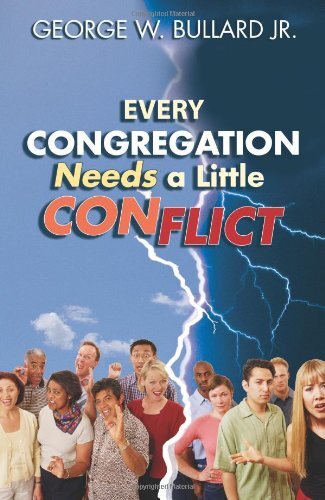George W. Bullard, Every Congregation Needs a Little Conflict (TCP Leadership Series). Chalice Press, 2008.
Referenced in: Managing and Resolving Church Conflict
LifeandLeadership.com Summary
Anything produced by The Columbia Partnership is worth reading, especially any book written by George Bullard, who always conveys a rich understanding of the realities of congregational life.
In this book, Bullard presents what is arguably the best explanation and application of the “Levels/Intensities of Conflict” and “Conflict Styles” models. One finds variations of this in classic material by Speed Leas and Ron Susek’s Firestorm, but Bullard offers a unique read on how conflict grows and escalates. In Bullard’s typical style, his writing moves quickly and succinctly. You get what you need without a lot of filler.
As the title suggests, Bullard believes conflict can be a constructive force for congregations if managed well. The opening chapter elevates the importance of conflict, suggesting conflict is natural and that congregations without it are dead or dying. He introduces seven reasons why congregations need conflict. He says congregations without conflict:
- Lack passion and direction
- Refuse to clearly define their beliefs and values for fear of conflict
- Avoid substantive issues because they are afraid of conflict
- Make shallow decisions from a group-think mentality
- Have ill-developed decision-making skills over complex issues because they have historically avoided conflict
- Lack the ability to keep conflict from escalating to an unhealthy intensity
- Do not take risks
Bullard next introduces the seven levels of conflict, and discusses each level in Chapters 2-8. This is followed by a helpful overview, congregational illustrations, suggestions on what one can expect, and the best strategies to use. Here is a brief overview of the seven levels:
- Level One Intensity: Typical Issues With Many Solutions
- Level Two Intensity: Common Disagreements Over Multiple Issues
- Level Three Intensity: Competition that Develops Causes
- Level Four Intensity: Now It’s Time to Vote or Else
- Level Five Intensity: Dividing the Medes from the Persians
- Level Six Intensity: Discrediting Our Enemies
- Level Seven Intensity: Destroying the Infidels
The point behind conflict levels theory is that if conflict is not addressed, it migrates up the intensity scale. The farther up it goes, the more unmanageable it becomes. The task is to capture and harness it as early as possible. In order to do this, one needs to know which style best fits the situation. This is where chapter 9 comes in.
In chapter 9, Bullard discusses the leadership/conflict styles, how to apply them to the seven intensities of conflict, how each is used, when it is and is not appropriate, etc. This is actually Bullard’s version of the seven styles discussed in Speed Leas’ Discover Your Conflict Management Style, though with difference nuances based on Bullard’s experience. The styles are support, accommodate, persuade, collaborate, negotiate, and compel.
In chapter 10, Bullard explains three main processes for dealing with conflict: resolution, mediation, and management. He advises as to which of these is most helpful at the various intensity levels, and how to identify the people in the congregation who need to be involved.
Chapter 11 is an excellent discussion of “Twenty Things to Do to Never Experience Unhealthy Conflict in Your Congregation.” Chapter 12 is addressed to denominational leaders, outlining what they can do to encourage healthy conflict competence on a congregational level.
From the Publisher
It’s no secret that congregations have conflict. Anyone who has served as a church leader knows about the friction that can take place within a congregation. And too much friction can lead to heated levels of infighting and strife. But used properly, can conflict really be a positive thing for your church?
The direct result of George Bullard’s twenty-five years of work in the area of training congregational and denominational leaders in various strategies to address conflict, this book empowers congregations to use conflict to deal with issues in a healthy and productive manner. In Every Congregation Needs a Little Conflict, Bullard guides church leaders in how to use conflict as a positive force for transition and change, and how to handle unhealthy conflict that might arise.
About the Author
George Bullard is a congregational and denominational leadership coach and editor of The Columbia Partnership Leadership Series from Chalice Press. He is also Project Director for Lake Hickory Learning Communities’ Sustaining Pastoral Excellence process, and wrote Pursuing the Full Kingdom Potential of Your Congregation.
***For additional information on this resource, including reviews, click the bookstore links. Check the reference at page top or the links below for resource guides on related topics.***
Related Areas
See Other Resources on Church Conflict:
See Resources on Over 100 Areas of Ministry Leadership:


